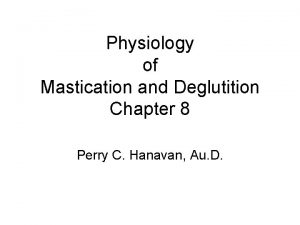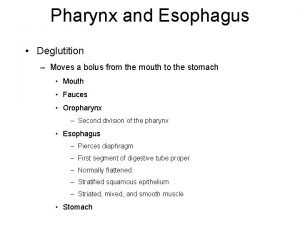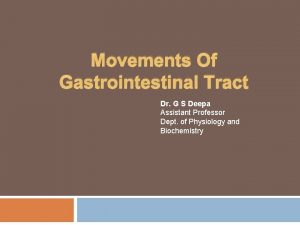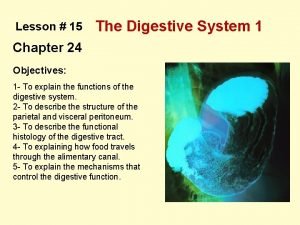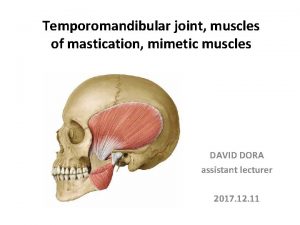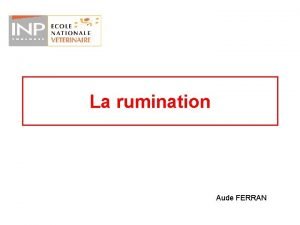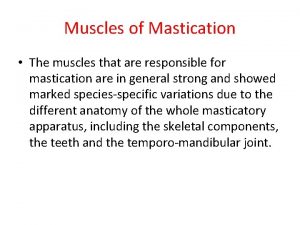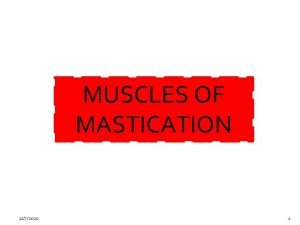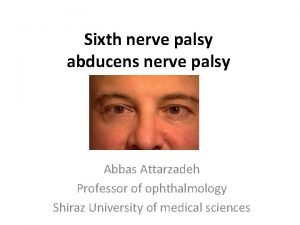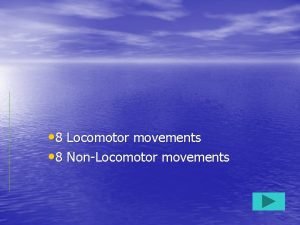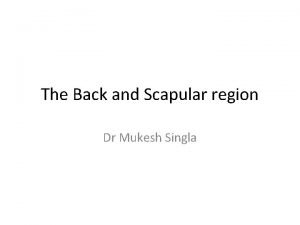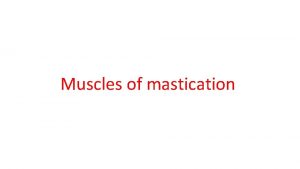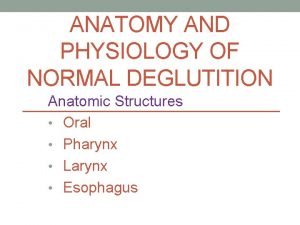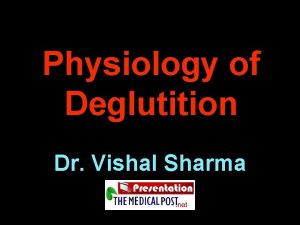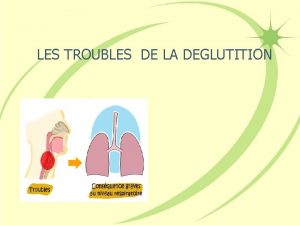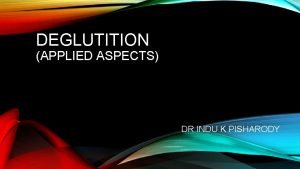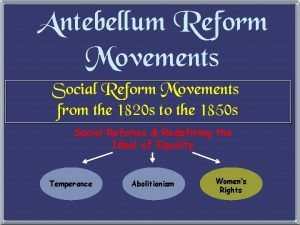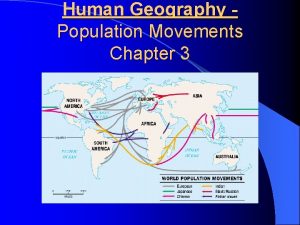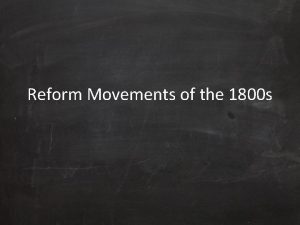MOVEMENTS OF G I T Mastication Deglutition Dr

















- Slides: 17

MOVEMENTS OF G. I. T. (Mastication & Deglutition) Dr. Abdul Majid Siddiqui Dept. of Physiology CIMS & H

MASTICATION (CHEWING) Definition: - This is the grinding of food into smaller particles with the help of teeth and jaw muscles. Functions of different teeth: - • Incisors: - provide strong cutting action. • Canines: - are responsible for tearing action. • Premolars & molars: -have grinding action.

Importance of mastication: ØGrinding makes easier for the food to be swallowed. ØIt mixes food with saliva & salivary enzymes ØGrinding of food into smaller particles also increases surface area & hence , the rate of digestion ØGrinding also prevents damage which food may Cause to the mucosa of G. I. T. ØMastication also breaks the indigestible Cellulose membranes, present around the nutrient portion of most of the fruits & raw – vegetables. ØFood also Comes in Contact with taste – receptors and also stimulates odour stimulating olfactory – receptors

Muscles of Mastication: I. Masseter muscle: - Ø Supplied by mandibular – division of v. cranial nerve. Ø It raises the mandible, clenches the teeth and help to protract (prolong) the mandible. II. Tempolaris - muscle: Ø supplied by same nerve. Ø It raises the mandible and retracts the mandible after protraction

III. Internal & External Pterygoid muscles: ØSame nerve supply. ØIt protrudes the mandible, depresses the chin. so it helps in opening the mouth and also produces grinding movement. IV. Buccinators muscle: - supplied by VIIth – cr. Nerve It is an accessory muscle of mastication. It prevents accumulation of foods between cheek & teeth

Muscles of Mastication

Control of mastication: It is Carried out, voluntarily; but mainly coordinated by reflexprocess Mastication – Reflex : Food (bolus) in mouth - reflex - inhibition of muscles of mastication - lower jaw dropped - stretching & so, Contraction of muscles of mastication through stretch reflex - lower jaw raises - closure of mouth – compression of bolue between teeth - Repeatation again & again. Centre of reflex: - Medulla, Efferent: - Vth - cr. Nerve (mandibular – branch)

DEGLUTITION (SWALLOWING) Definition: - ØThe process of passage of food from oral; Cavity into the stomach, through esophagus - is known as deglutition (swallowing). Stages: - 3 stages: Buccal / oral sage : - a voluntary stage Pharyngeal stage : - Involuntary stages(both), with reflex Esophageal stage : - processes, The reflex is controlled by Xth (vagus) – nerve. The center is present in medulla.

I. ORAL / BUCCAL – STAGE: - a voluntary stage – 1. Food is rolled on the upper surface of tongue and a bolus (a rounded mass of food) is formed by mixing with saliva. 2. The soft palate rises and the posterior part of nasapharynx approaches towards the soft palate nasal regurgitation of food. 3. The respiration is reflex stopped. 4. Now, the bolus is pushed to the posterior part of the tongue, i. e. towards pharynx.

Stages of deglutition. A. Preparatory stage; B. Oral stage; C. Pharyngeal stage; D. Esophageal stage

Swallowing mechanism.

II. PHARAYNGEAL – STAGE: - A reflex process a. Deglutition (swallowing) reflex: Food present at posterior part of tongue & in opening of pharynx at Tactile opening of pharynx Cranial nerves stimulation of receptors, present in area of Afferent-impulses, through V& IX Deglutition efferent impulses , through V, VII , X & XII sequence of events in pharyngeal phase Center (in medulla) cranial nerves

b. Sequence of events in deglutition reflex: 1. Tongue pressing against hard palate & increasing intra – oral pressing - prevention of entry of food back into oral Cavity. 2. Backward & upward movement of soft palate - approximation of soft palate with the post. Pharyngeal wall - prevention of entry of food into nasal Cavity. 3. Forward and upward movement of larynx , approximation of the vocal cords , and epiglottis forming a hood like Covering over the larynx Prevention of entry of into larynx. The respiration stops for a while - ‘Deglutition – apnea’

4. Entry of food from pharynx into esophagus: i. Palate pharyngeal folds on either side of pharynx approximate - to make a slit like opening for food passage - allowing only properly masticated food, to pass through it ii. (Simultaneously, upper 3 -4 cm of esophagus relaxes; i. e. relaxation of upper esophageal - sphincter (U. O. S. ). iii. (At the same time, the entire pharyngeal muscle wall Contracts from superior to inferior part - & originating a false peristaltic wave - which also continues, in esophagus.

III. OESO PHAGE AL – STAGE: It conducts the food from esophagus to stomach, by movements, as follows: - a. PRIMARY - PERISTALSIS : - is simply a Continuation of peristaltic wave initiated in pharynx ØIt takes 8 -10 secs. to carry food to the stomach. ØBut in upright position - food passes to stomach, earlier; in 5 -8 secs - due to added effect of gravity.

b. SECONDARY – PERISTALSIS: - When Primary peristalsis fails to carry all food to stomach. – Sec. Purist, wave - is initiated in esophagus; due to distances ion of esophagus with food. ØThese waves continue – till all the food is emptied into the stomach. ØThese waves are produced – due to intrinsic nerve plexuses, present in the wall, & party due to vagal reflex

 Stages of deglutition
Stages of deglutition Deglutition stages
Deglutition stages Brush border enzymes
Brush border enzymes Physiology of deglutition
Physiology of deglutition Vomiting reflex
Vomiting reflex Process of deglutition
Process of deglutition Axial movements examples with pictures
Axial movements examples with pictures Mandibular fossa
Mandibular fossa Anisognathia
Anisognathia Muscles of mastication innervation
Muscles of mastication innervation Muscle of mastication
Muscle of mastication Movement of mandible
Movement of mandible Introduction definition
Introduction definition Abducens nerve palsy
Abducens nerve palsy Extrapyramidal movements
Extrapyramidal movements Extrapyramidal movements
Extrapyramidal movements What is non locomotor movements
What is non locomotor movements Scapular movements
Scapular movements
